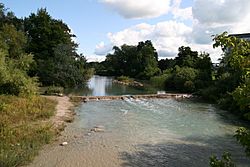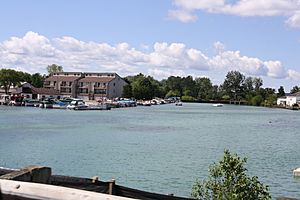Elk River (Michigan) facts for kids
Quick facts for kids Elk River |
|
|---|---|

Elk River
|
|
| Physical characteristics | |
| Main source | Elk Lake 44°53′08″N 85°24′14″W / 44.88555°N 85.40388°W |
| River mouth | Grand Traverse Bay, Lake Michigan 44°54′06″N 85°24′49″W / 44.90166°N 85.41368°W |
| Length | 1.5 mi (2.4 km) |
The Elk River is a small but important river in Michigan, USA. It's only about 1.5 miles (2.4 km) long! This river flows from Elk Lake into Grand Traverse Bay, which is part of Lake Michigan. The Elk River helps create a waterway and harbor for the town of Elk Rapids.
Contents
How the Elk River Was Formed
Elk Lake is very deep, about 192 feet (58.5 meters)! Long ago, Elk Lake was actually connected to Lake Michigan. But then, the water level of Lake Michigan dropped. This caused a natural barrier of sand and dirt to form. This barrier separated Elk Lake from Grand Traverse Bay. Because of this, the short, fast-flowing Elk River was created. It helps drain water from Elk Lake into Lake Michigan.
The River's Name: From Eagles to Elk
Native American Name
The Native Americans who lived here called this quick river Meguzee. This name honored the Anishinaabe word for the bald eagle. Eagles were very important to them.
European Settlers and a New Name
In the early 1800s, European settlers arrived in the area. In 1858, someone found a pair of elk antlers in the river's rapids. Because of this discovery, the rapids, the river, and Elk Lake were all renamed after the elk.
The River Today
The fast-moving rapids of the Elk River are now much calmer. This is because a hydroelectric dam was built on the river. A hydroelectric dam uses the power of moving water to create electricity.
Boats cannot simply go over the dam. Instead, people must portage their boats. This means they take their boats out of the water and move them around the dam using special boat ramps. Below the dam, the river widens and flows into Grand Traverse Bay. This wider part of the river forms the busy harbor of Elk Rapids.


